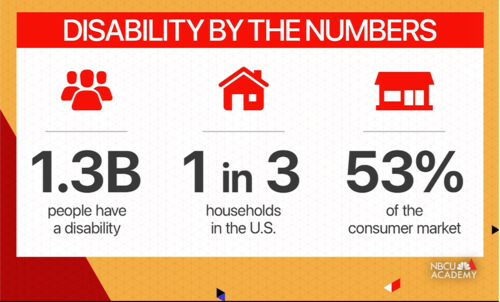NBCU Academy 101
Lori Samuels, accessibility director at NBCUniversal, works with all the corporation’s businesses and brands, including NBC News, MSNBC, CNBC and NBCU Academy. She discusses how news stories can reach everyone, including people with disabilities.
Almost all of us will experience some disability in our lifetimes. Some of us are born with disabilities, others acquire them through an accident or injury or illness. Many of us age into disability.
Disability can be categorized into broad categories of sensory, physical or mobility, and cognitive.
- Sensory disabilities include vision loss or hearing loss.
- Physical disabilities include mobility issues or limb differences.
- Cognitive disabilities is a broad category that includes autism, ADHD, dyslexia and certain mental health conditions. They impact affect how people with such disabilities interact with the world.

About 1.3 billion people worldwide have a disability. In the United States, it’s 1 in 3 households, making the disability community the largest U.S. minority. When combined with friends and family, that’s 53% of the consumer market.
Every other dimension of human existence, like race, gender and sexual orientation, intersects with disability. If you’re doing a news story on a particular community, consider getting the perspective of people with disabilities within that community.
When people with disabilities consume news, they might use certain accessibility features like:
- Closed captioning for video.
- Screen readers to listen to content on apps, websites and social media. IPhones and iPads have a screen reader called VoiceOver and Android devices have a screen reader called TalkBack.
- Magnifying text on a screen or changing text colors. Some readers prefer white or light text on a dark background, while others prefer dark text on a light background.
- Using a keyboard instead of a mouse to move on a computer.
- Using their voice to interact with apps or content.
Here are important tips for media accessibility:
- Closed captions: All video content needs closed captioning. About 80% of the people who use captions regularly are not hearing impaired, but captioning is essential for folks who are.
- Automated captions: This tool automatically generates captions from the dialogue in the video. Make sure to proofread them.
- Describe images. Display a text description that goes along with an image for people who are blind or have low vision. Image descriptions are sometimes called “alt text.” They’re also helpful for SEO or Google search results and analytics.
- Sharp contrast for text: When publishing a story in a digital app or platform, make sure the text has a sharp contrast to the background so anyone can easily read it. Similarly, for colorblind readers, put labels on charts or graphs that are conveying important data or information.



